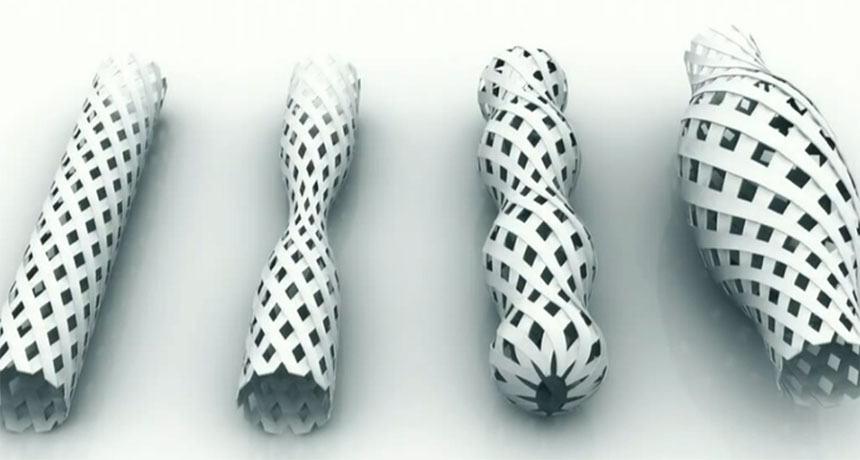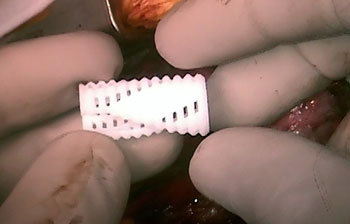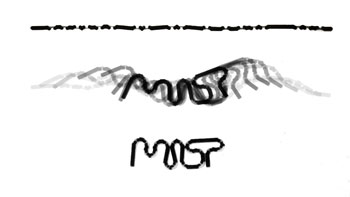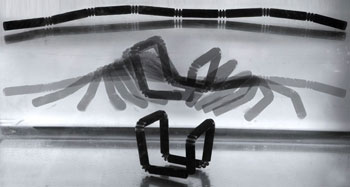How to print shape shifters
4-D printing aims to make objects that can build themselves and interact with the world

4-D printing produces objects that can change after they are created. These tubes can change shape according to the temperature and the pressure of the fluids that flow through them.
MIT
“Can we print a robot that can walk out of a printer?”
That question almost sounds like a joke. But Hod Lipson wasn’t kidding around. Lipson is an engineer at Cornell University in Ithaca, N.Y. And he issued that challenge earlier this year in the scientific journal 3D Printing and Additive Manufacturing. Lipson’s question has to do with an emerging technology called 4-D — or four-dimensional — printing. Among engineers and scientists, buzz is growing about this field because it expands the limits of what a printer can print.
Most objects that emerge from a 3-D printer just sit there. They can’t do anything without human intervention. And they remain the same no matter where they go. In contrast, a 4-D printed object can respond and adapt to its environment. It may change shape or size or color.
Even though the technology is new, scientists have a long list of possible applications.
Imagine “printed” water pipes that push water along by undulating along their length. Soldiers on the battlefield might wear camouflage that changes color to fit the surroundings or weather. Even more-far-reaching proposals include adaptable human stations in space or on distant planets that might be fashioned with 4-D printing. And researchers like Lipson think 4-D printing could have a big impact on robotics: Printers could print robots that build printers that build robots.
But for these applications to become reality, scientists first have to design “smart” materials, which have their function built in.
Or, as Skylar Tibbits puts it, “Is it possible to program things, and not just computers?” Tibbits, a researcher at the Massachusetts Institute of Technology in Cambridge is a pioneer in 4D printing. “It’s not only about printing any more,” he says. It’s also about: “How can we program any material to change its shape and property on demand?”
Printing life savers
3-D printing gets its name because it prints solid objects that have three dimensions. The fourth dimension in 4-D printing comes from time. In physics and math, time is often considered as the dimension that comes after length, width and height. Solid objects may change over time. They may move, morph in shape or change in other ways. Similarly, a 4-D printed object is something that’s designed to change after it’s printed.
The list of potential applications for 4-D printed objects reaches across scientific disciplines and uses.
Eujin Pei, at England’s Brunel University London, offers as an example: window shades that can change to allow more or less light in during the day. “Maybe when the sun rays shine in and hit a certain temperature, [the blinds] will curl up and close the windows for you,” he says. Right now, blinds have to be adjusted by hand or by levers and small motors. The advantage of 4-D printing is that the ability to change shape can be built into the material itself — without needing outside forces. “The material,” he explains, “is intelligent enough to do what you want it to do.”
Pei thinks 4-D materials have something in common with carnivorous plants like the Venus flytrap or pitcher plants. When a bug lands on one of these plants, it triggers an automatic response. The plant closes, trapping the bug inside where it is slowly digested. That provides food for the plant. Similarly, a 4-D material has a specific action that happens only when it’s triggered.
“The principle is the same, though the materials are much different,” Pei says.

The disease usually goes away by age two or three. The doctors’ goal was to create a device that could be implanted in the boys’ throats to support them through the dangerous early years.
Researchers used computers to make three-dimensional X-ray images of the boys’ tracheas. They sent those scans to a computer program. It then designed a device, called an “airway splint,” that could hold the trachea open. The researchers created the devices on a 3-D printer using a special, safe plastic that’s much like the trachea’s tissue. Doctors surgically implanted the splints into each boy. And the devices worked!
Over the next three years, the device expanded as each boy grew. And the boys, born with a life-threatening condition, began to live normal lives.
Wonderlab at MIT
Last year, Tibbits stood before a packed auditorium in California and gave the audience a glimpse of the 4-D future. It was a thin strand that looked like a black pipe cleaner. Though it looked simple, appearances can be deceiving. After the strand was plunged into a tank of water, it began to wiggle on its own. Segments on the ends rose and twisted, as though the strand had hidden hinges. The middle segments, too, twisted into place. Within a few seconds, the strand had morphed from a straight line into three clear letters: M-I-T.
“What can I say? I’m biased,” Tibbits told the crowd. (After all, he does work at MIT.) He and his team had designed it in collaboration with Stratasys, a 3-D printing company.

And that strand was just the beginning. Researchers in Tibbits’ lab are constantly looking for new ways to print stuff that can respond to the world around it. Researchers often refer to such materials as being “smart.”
In his lab, Tibbits says “every day is different.” His team, he explains, strives to “invent new technologies and push the boundaries of what’s possible, and discover new science behind it.” The researchers are working on “a ton of different projects” at once.
Their work on 4-D printing grew out of an interest in creating materials that “self-assemble,” or transform. In addition to working on printed materials, they have worked with different materials, such as wood, carbon, plastic and metal to make self-assembling structures. They’ve met with companies that want to create everything from sportswear to spacecraft, furniture to packing supplies. Tibbits says his team develops the technology for other people to use in applications. His team has created many different structures that “self-evolve” — which means they can change in different settings, such as water, heat or light. Many of those were printed.
DESCRIBING A REVOLUTION Skylar Tibbets is pioneering 4-D printing at MIT. TED |
Right now, the sky’s the limit. “We’re playing around all the time,” Tibbits says.
Printing smart materials has another advantage: Less waste. Tibbits thinks materials can be programmed to work in a certain way and also to stop working in a certain way.
“All of these future programmable products will not just be thrown away when they fail,” says Tibbits. “They will error-correct and self-repair to meet new demands. And even when they become obsolete, they can self-disassemble to be recycled. They can break themselves down to their fundamental components, to be reconstituted as new products with lifelike capabilities in the future.”
Reality check
Kevin Ge Qi has helped develop 4-D printing techniques. As a materials scientist, he works with shape-memory plastics at the Singapore University of Technology and Design. These materials can change from one shape into another as conditions change. For instance, they might be triggered to change when they heat up, get wet or are illuminated by certain types of light.
SHAPE SHIFTER This video, which plays at 100 times normal speed, shows what happens to the engineered strand after it is placed in water. It forms the letters “M-I-T.” Stratasys & The Self-Assembly Lab at MIT |
In Qi’s lab, scientists have used 3-D printers to print plastic sheets that can fold themselves into different shapes. They call the approach “active origami.” Already, they have printed sheets that fold themselves into a box, a pyramid or an airplane. Another of their creations was a three-dimensional box that unfolded itself into a sheet and then reformed back into a box.
4-D printing technology hints at a future filled with smart applications. As with any emerging technology, however, many obstacles remain before that future becomes reality. Qi points to two big challenges.
“Currently, the major challenge for 4-D printing is the material,” he says. Most of those used in traditional manufacturing are not suitable for 3-D or 4-D printing, he says. That’s why he and other researchers are trying to develop a catalog of materials — and combinations of those materials — that should prove useful.
Another obstacle is size. Most commercial 3-D printers that use different materials can make objects no smaller than a few centimeters. But that’s too big to be useful for most medical applications, he says. “If we want to advance the technology to biomedical devices, the size needs to be about a few microns or even smaller.” (A micron is one-millionth of a meter.)

Even with those challenges, though, researchers like Qi and Tibbits see a bright future. Tibbits says the time has come to rethink how we make things. And 4-D printing is one way to do that.
“We invite you to join us in reinventing and reimagining the world,” he said in California.







